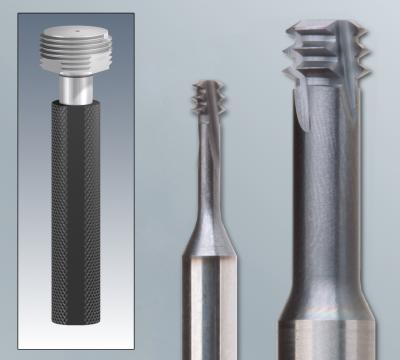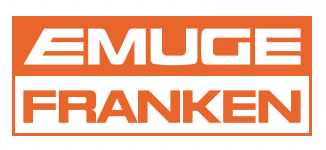
EMUGE-FRANKEN USA, a leading manufacturer of high-performance taps, thread mills, end mills, drills, and other rotary tools, has announced it has expanded its line of SELF-LOCK thread locking tools to include new EMUGE ZGF-S-Cut Thread Mills, in addition to EMUGE High Ramp Precision Thread Gages designed for gaging EMUGE SELF-LOCK thread profiles.
The new ZGF-S-Cut SELF-LOCK Thread Mills with helical flutes, multiple teeth and TIALN-T46 coating produce self-locking threads that are ideal in demanding industry applications such as aerospace where nickel alloys, titanium and stainless steel are the norm. A unique design enables three tooth pitches to simultaneously rough and finish-cut threads, dramatically increasing tool life and reducing cycle times.
“As the demand for self-locking threads for safety critical applications increases, our new ZGF-S-Cut SELF-LOCK thread milling products with unique geometry provide more threading options,” said Marlon Blandon, Thread Milling Product Manager, EMUGE-FRANKEN USA. "Interest in our SELF-LOCK threading tools, which have been successfully applied for years, continues to rise.”
The new EMUGE ZGF-S-Cut self-locking thread mills have a left-hand helix flute design with left-hand spindle rotation, which greatly enhances stability and cutting performance. The first of three cutting teeth acts as a rougher, while the second and third teeth finish the full thread profile, providing perfect threads, exceptional cycle time reductions and longer tool life. TIALN-T46 coating resists heat and wear and further extends tool life. “Our ZGF-S-Cut design provides tool life which can exceed 10 times that of conventional thread mills,” said Blandon. The new thread mills are available in 16 sizes from 2-56 up to ½-20" for UNC or UNF threads, and tools starting at the ¼" size and larger feature axial coolant capability.
New EMUGE High Ramp Precision NO-GO Thread Plug Gages have also been added to the EMUGE SELF-LOCK line. The gages are used to check the lower thread ramp point for possible ramp angle errors and are used along with standard EMUGE SELF-LOCK Thread Plug Gages to verify all thread profile features.
The special profile of EMUGE SELF-LOCK threads allows an even distribution of stress over the entire thread length, eliminating slippage. Compared with standard threads, EMUGE SELF-LOCK internal threads show constant, maximum holding power under dynamic stress. Functions remain in good operation even with repeated loosening and re-tightening of the thread connection. The locking effect is caused by the ramp-shaped surface integrated into the thread profile. EMUGE SELF-LOCK technology results in increased threading tool life for larger thread hole diameters and provides larger tolerances for thread hole diameters.
Other EMUGE SELF-LOCK products include UNC and UNF Cut Taps, UNC and UNF Form Taps; Metric Cut Taps, Metric Form Taps and Metric Thread Mills, in addition to GO/ NO-GO Thread Gages. To see the full range of EMUGE SELF-LOCK threading tools, visit https://www.emuge.com/products/taps/self-lock-taps.
Contact Details
Related Glossary Terms
- alloys
alloys
Substances having metallic properties and being composed of two or more chemical elements of which at least one is a metal.
- coolant
coolant
Fluid that reduces temperature buildup at the tool/workpiece interface during machining. Normally takes the form of a liquid such as soluble or chemical mixtures (semisynthetic, synthetic) but can be pressurized air or other gas. Because of water’s ability to absorb great quantities of heat, it is widely used as a coolant and vehicle for various cutting compounds, with the water-to-compound ratio varying with the machining task. See cutting fluid; semisynthetic cutting fluid; soluble-oil cutting fluid; synthetic cutting fluid.
- flutes
flutes
Grooves and spaces in the body of a tool that permit chip removal from, and cutting-fluid application to, the point of cut.
- gang cutting ( milling)
gang cutting ( milling)
Machining with several cutters mounted on a single arbor, generally for simultaneous cutting.
- milling
milling
Machining operation in which metal or other material is removed by applying power to a rotating cutter. In vertical milling, the cutting tool is mounted vertically on the spindle. In horizontal milling, the cutting tool is mounted horizontally, either directly on the spindle or on an arbor. Horizontal milling is further broken down into conventional milling, where the cutter rotates opposite the direction of feed, or “up” into the workpiece; and climb milling, where the cutter rotates in the direction of feed, or “down” into the workpiece. Milling operations include plane or surface milling, endmilling, facemilling, angle milling, form milling and profiling.
- threading
threading
Process of both external (e.g., thread milling) and internal (e.g., tapping, thread milling) cutting, turning and rolling of threads into particular material. Standardized specifications are available to determine the desired results of the threading process. Numerous thread-series designations are written for specific applications. Threading often is performed on a lathe. Specifications such as thread height are critical in determining the strength of the threads. The material used is taken into consideration in determining the expected results of any particular application for that threaded piece. In external threading, a calculated depth is required as well as a particular angle to the cut. To perform internal threading, the exact diameter to bore the hole is critical before threading. The threads are distinguished from one another by the amount of tolerance and/or allowance that is specified. See turning.

